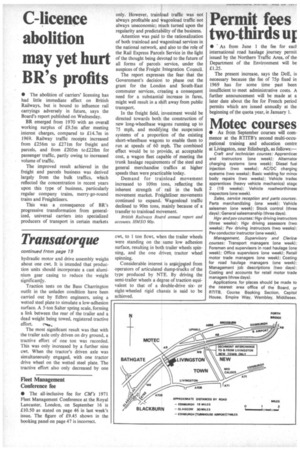C-licence abolition may yet hurt BR's profits
Page 28

If you've noticed an error in this article please click here to report it so we can fix it.
• The abolition of carriers' licensing has had little immediate effect on British Railways, but is bound to influence rail carryings adversely in future, says the Board's report published on Wednesday.
BR emerged from 1970 with an overall working surplus of £9.5m after meeting interest charges, compared to £14.7m in 1969. Railway traffic receipts increased from £256m to £271m for freight and parcels, and from £205m to £228m for passenger traffic, partly owing to increased volume of traffic.
The improved result achieved in the freight and parcels business was derived largely from the bulk traffics, which reflected the concentration in recent years upon this type of business, particularly regular company trains, merry-go-round trains and Freightliners.
This was a consequence of BR's progressive transformation from generalized, universal carriers into specialized producers of transport in certain markets only. However, trainl ad traffic was not always profitable and vagonload traffic not always uneconomic; nuch turned upon the regularity and predictability of the business.
Attention was paid to the rationalization of both trainload and wagonload services in the national network, and also to the role of the Rail Express Parcels Service in the light of the thought being devoted to the future of all forms of parcels service, under the auspices of the Freight Integration Council.
The report expresses the fear that the Government's decision to phase out the grant for the London and South-East commuter services, creating a consequent need for a substantial increase in fares, might well result in a shift away from public transport.
In the freight field, investment would be directed towards both the construction of new long-wheelbase wagons running up to 75 mph, and modifying the suspension systems of a proportion of the existing short-wheelbase wagons to enable them to run at speeds of 60 mph. The combined effect would be to provide, at acceptable cost, a wagon fleet capable of meeting the trunk haulage requirements of the steel and general merchandise traffics at higher speeds than were practicable today.
Demand for trainload movement increased to 109m tons, reflecting the inherent strength of rail in the bulk movement market. Freightliner movements continued to expand. Wagonload traffic declined to 90m tons, mainly because of a transfer to trainload movement.
British Railways Board annual report and accounts. HMSO 90p.










































































































